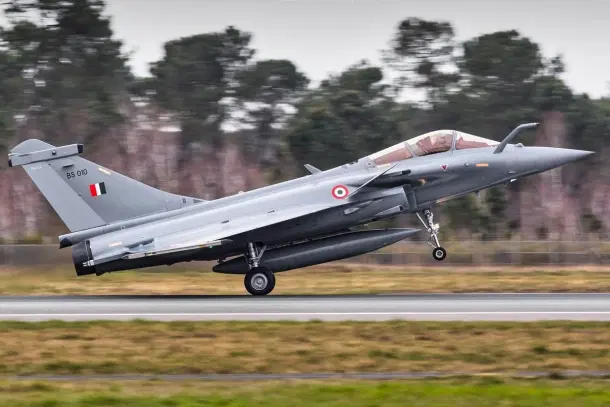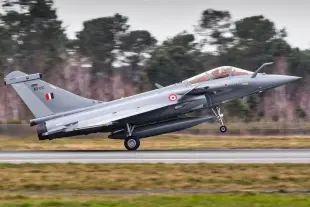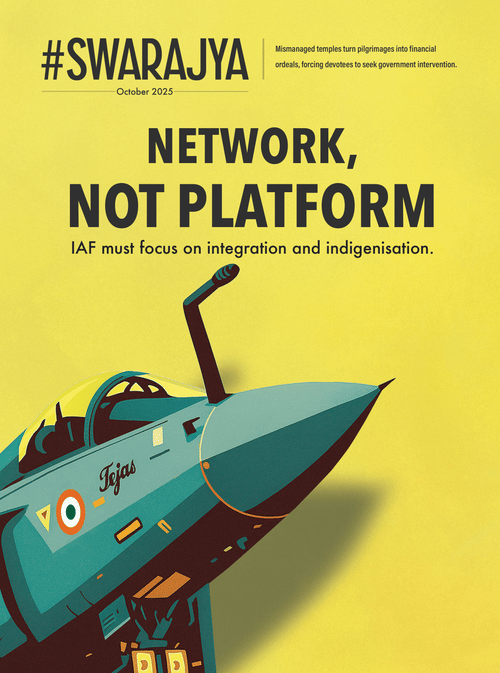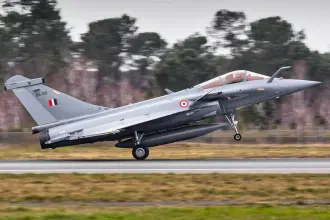Defence
Operation Sindoor Showed The IAF’s Strength, But Also Its Blind Spots
Swarajya Staff
Oct 22, 2025, 02:28 PM | Updated 03:31 PM IST
Save & read from anywhere!
Bookmark stories for easy access on any device or the Swarajya app.


If one was scrolling through X or Twitter yesterday, it was impossible to miss the flood of citations for the gallantry awardees of Operation Sindoor. Yet, alongside the accolades, a parallel debate has been simmering, sparked by a critical piece from a naval veteran examining the performance of the IAF during the operation.
There is little doubt that the IAF delivered a devastating blow to Pakistan in Operation Sindoor. It obliterated the JeM and LeT mosque complexes in Bahawalpur and Muridkie, targets that had long stood as grim symbols of India’s inability to punish Pakistan’s military-jihad nexus. Nearly a dozen Pakistani airbases were hammered with pinpoint accuracy, while successive waves of Pakistani counterattacks were intercepted and neutralised by the Integrated Air Command and Control System (IACCS).
Yet, as the post-Operation Sindoor euphoria begins to settle, the IAF faces some hard questions.
Much of the public debate has focused on whether India got its money’s worth from the Rafales. The fact that 36 Rafales equipped with Meteor missiles cannot tip the balance in beyond-visual-range air combat should not be difficult to grasp. Moreover, with China for help, Pakistan will almost always have access to countermeasures, such as PL-15–equipped J-10s in this case, capable of blunting, if not matching, India’s capabilities.
But IAF has only itself to blame for the questions over the Rafales. For years, the service presented the aircraft as a silver bullet that would decisively shift the balance. This reflects a deeper problem. The IAF has long suffered from a platform-centric mindset, believing that air superiority comes from acquiring the next aircraft rather than integrating all its assets into a single, intelligent network.
No aircraft, however advanced, can deliver its full potential without a robust digital backbone connecting it to other sensors, shooters, and command nodes.
What the IAF urgently needs is not just more squadrons of jets but a force-wide commitment to networking and integration. This means building secure, interoperable data links, standardised communication protocols, and a common operational picture across every platform in the inventory. This is not to say the IAF does not need new fighters. It does, and with urgency. But that it must move away from its entrenched platform-centric mindset if it hopes to leverage its full combat potential.
To be fair, it has made some important strides. The IACCS is a major success story and arguably one of the most capable battle-management networks in the developing world. During Operation Sindoor, it performed with distinction, knitting together multiple ground-based and airborne sensors, enabling rapid threat detection, and allowing the IAF to operate with speed and coherence.
It proved that when the architecture works, Indian air power can deliver results. Yet it also exposed the unevenness of the system, as only parts of the IAF are truly networked.
That unevenness runs deep into the IAF’s sensor ecosystem. The absence of a secure, service-wide data link was brutally revealed after the Balakot air strikes in 2019, when the IAF had to rush-buy Software Defined Radios (SDRs) from Israel under emergency provisions.
Tactical data links form the backbone of modern aerial warfare, carrying voice and digital messages between fighter aircraft, ground radars, and airborne surveillance platforms, allowing the tactical picture to build in real time. The more integrated and secure these links are, the faster detection, targeting, missile guidance, and strike outcomes can be executed.
The obvious question is why this was done after and not before a crisis. If an emergency purchase was possible, why was it not treated as an operational necessity earlier?
The cost of that delay may never be publicly acknowledged, yet it is hard to escape the conclusion that the lack of secure, encrypted communications complicated the IAF’s ability to coordinate during Pakistan’s counter-attack the next day. An Indian fighter was lost and a pilot was captured and paraded on Pakistani television.
For several tense hours, political leaders in New Delhi faced an acute dilemma over escalation. We may never know how much that gap shaped decision-making at the highest level, yet the incident should have been the IAF’s wake-up call.
Six years later, the IAF still lacks a fully indigenous encrypted tactical data link connecting all its frontline assets. The integration of legacy platforms, including MiG-29s, Mirage-2000s, and Jaguars, into a common information grid remains incomplete.
The Pakistan Air Force appears to have done a better job at networking its assets, using either what it calls the "indigenous" Data Link 17 or the Chinese XS-3 tactical data link, which reportedly connects Chinese-made fighters with other platforms, including a Swedish-made surveillance aircraft.
The operational effect is straightforward and worrying. J-10s operating close to the Line of Control can receive targeting data from an Erieye flying well inside Pakistani airspace, keep their own radars switched off to reduce signature, and still be cued to launch long‑range PL‑15 missiles from stand‑off positions. In practice, this creates a multi‑domain kill chain that lets surveillance, shooters and missile guidance act as a single, coordinated system rather than as isolated platforms.
This degree of integration changes the tactical equation and appears to have been one of the key differences between the two sides during Operation Sindoor.
Networked sensors and weapons can multiply the reach and survivability of a smaller air force, and they blunt the advantage of superior individual aircraft if those aircraft cannot be plugged into an equally resilient, secure data backbone.
Even within the IACCS, interoperability with the Navy’s and Army’s networks is patchy, and cross-domain situational awareness is more aspirational than operational. The service’s focus on high-end imports rather than systems integration, secure communications, and data fusion betrays an institutional bias towards hardware over architecture.
In an era of network-centric warfare, this is not a peripheral issue but the foundation of combat effectiveness. Equally important is whether any new platform can be seamlessly integrated into the wider command and control and sensor network. Its standalone capabilities are secondary if it cannot contribute to a unified operational picture.
The lack of robust airborne early-warning surveillance capabilities also reveals how the IAF’s focus on high-end platforms has often come at the expense of operationally integrated, networked systems.
In the early 2000s, India acquired three A-50EI Phalcon AWACS systems from Israel and Russia, each featuring an IAI EL/W-2090 AESA radar mounted on an upgraded Ilyushin Il-76TD, providing 360-degree coverage and a detection range of over 400 km. The fleet suffered from persistently low serviceability. Despite these challenges, the IAF wanted to expand the fleet, but the plan to acquire two additional Phalcons were stalled by 2017 as costs soared, leaving it with a tiny fleet of surveillance aircraft with poor operational availability.
The indigenous Netra AEW&C entered service the same year, offering more limited 240-degree radar coverage and a 250-km range. It was not ideal but it was the best the IAF had. Pakistan, meanwhile, fielded multiple Erieye AEW&C systems with continuous coverage, giving it the ability to exploit gaps in India’s radar picture.
Yet the IAF did not push urgently for more Netra platforms, betting instead on the distant and costlier AWACS-India project, an ambitious plan to mount a 360-degree AESA radar on an Airbus A330. That programme is still years away.
Only in 2025 did the requirement for six upgraded Netra Mk1A systems move forward. Bureaucratic inertia at the Ministry of Defence may partly explain the delay, yet the IAF’s own short-sightedness, its reluctance to prioritise what was available and operationally proven, is equally to blame.
The IAF’s airborne surveillance roadmap today is years behind where it should have been and the delay is largely self-inflicted. Had the service pushed for additional Netra AEW&C platforms in 2019 or 2020, when the need for persistent airborne radar coverage was glaringly evident after Balakot, it would by now have a far stronger and more resilient “eye in the sky.”
Instead, it chose to wait for next-generation systems that remain years from operational reality. The upgraded AEW&C Mk.1A, six Embraer-145–based platforms, is still at a developmental stage, with deliveries unlikely before the latter half of this decade. By the time the IAF decided to push for more Netra aircraft, Brazilian planemaker Embraer had shut down the ERJ-145 production line, leaving India scrambling in the secondary market for used aircraft.
The more ambitious AEW&C Mk.II project, involving radar integration on six pre-owned Airbus A321s, is only now entering the structural modification phase with AIESL and Airbus Defence and Space in Spain. India’s airborne early-warning capability continues to languish in a holding pattern, a casualty of the IAF’s habitual preference for the perfect over the practical.
Despite the fanfare over an IAF S-400 strike that reportedly took out a Pakistani Erieye AEW&C, the harsh reality is that the Pakistan Air Force remains years ahead of India in airborne early-warning capability.
If Operation Sindoor has demonstrated anything, it is that when India’s air defence network works as designed, it can deliver decisive outcomes. That success must not mask the structural gaps that remain. The IAF cannot afford to wait for the next crisis to fix its network backbone. It must now treat networking, integration, and indigenous SDR development as its highest modernisation priority, not as a technical afterthought.
In contemporary air operations, the strength of a force depends less on the quantity of aircraft and more on the integration of fighters, sensors, and command systems. The IAF needs numbers, but what it needs equally urgently is a focus on ensuring those assets can operate seamlessly together.





